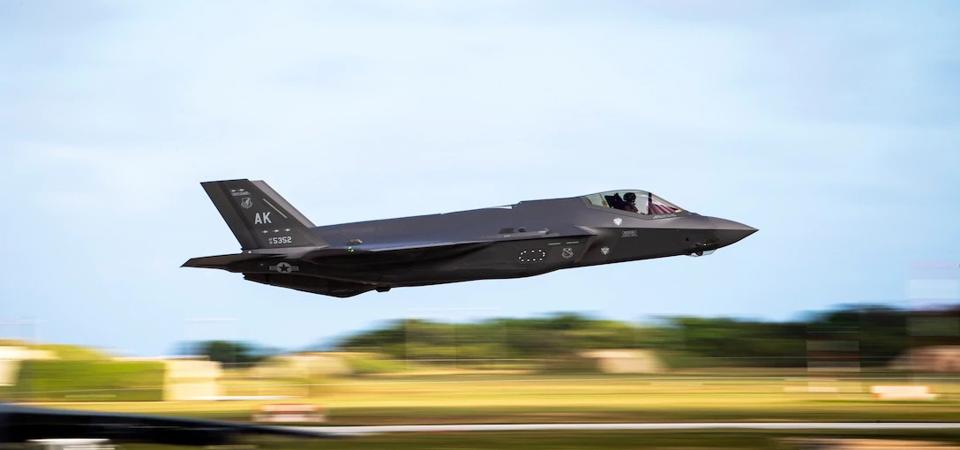Nederland koopt extra F-35 jachtvliegtuigen
Defensie koopt 9 F-35 jachtvliegtuigen extra. Staatssecretaris Barbara Visser heeft dit de Tweede Kamer vandaag per brief laten weten. Het totale aantal F-35’s voor de luchtmacht komt daarmee op 46.
Door 9 toestellen aan de huidige vloot toe te voegen is Defensie beter in staat de grondwettelijke taken uit te voeren. Daarnaast wordt met de aanschaf de basis gelegd voor een 3e F-35 squadron.
Sneller bij (potentiele) conflicten
De Koninklijke Luchtmacht moet 24/7 het Nederlandse luchtruim bewaken. Tegelijkertijd dient het krijgsmachtdeel met 4 toestellen eenmalig of langdurig 1 missie uit te voeren.
Door 9 vliegtuigen inclusief personeel aan het vliegtuigenbestand toe te voegen, daalt de belasting voor mensen voor een langdurige missie wezenlijk. Ook is de inzetbaarheid te verdelen over meer vliegtuigen. Dit heeft een positief effect op het voortzettingsvermogen van de F-35, doordat de vliegurenbelasting per toestel daalt. Ook verbetert de inzetbaarheid. Indien nodig is Nederland sneller aanwezig bij (potentiele) conflicten.
Een en ander inbegrepen
Bij de verwerving is een en ander inbegrepen. Denk aan de in het begin benodigde reservedelen en trainingsmiddelen zoals simulatoren en informatievoorzieningssystemen. Verder gaat het om speciale gereedschappen, meet- en testapparatuur en vliegtuig gebonden apparatuur. De gang van zaken bij de 9 extra F-35’s verloopt daarmee hetzelfde als bij de 37 reeds bestelde jachtvliegtuigen.
Wel is voor de 9 toestellen infrastructuur nodig, waaronder enige nieuwbouw. Deels volstaat het om bestaande infrastructuur aan te passen. Daarnaast vergt de komst van 9 extra F-35’s mobiele infrastructuur voor uitzendingen en oefeningen.
De kosten
De kosten worden geraamd op ongeveer € 1 miljard. Dit bedrag past volledig binnen het budget dat voor het Nationaal Plan beschikbaar is gesteld bij de Voorjaarsnota.
De F-35 vervangt de F-16 waarmee de luchtmacht sinds 1979 vliegt. Nederland kocht er ooit 213. Inmiddels vliegen er nog 61 van deze verouderde toestellen.
https://www.defensie.nl/actueel/nieuws/2019/10/08/nederland-koopt-extra-f-35-jachtvliegtuigen
The U.S. Air Force Just Admitted The F-35 Stealth Fighter Has Failed
The U.S. Air Force’s top officer wants the service to develop an affordable, lightweight fighter to replace hundreds of Cold War-vintage F-16s and complement a small fleet of sophisticated—but costly and unreliable—stealth fighters.
The result would be a high-low mix of expensive “fifth-generation” F-22s and F-35s and inexpensive “fifth-generation-minus” jets, explained Air Force Chief of Staff Gen. Charles Brown Jr.
If that plan sounds familiar, it’s because the Air Force a generation ago launched development of an affordable, lightweight fighter to replace hundreds of Cold War-vintage F-16s and complement a small future fleet of sophisticated—but costly and unreliable—stealth fighters.
But over 20 years of R&D, that lightweight replacement fighter got heavier and more expensive as the Air Force and lead contractor Lockheed Martin
Yes, we’re talking about the F-35. The 25-ton stealth warplane has become the very problem it was supposed to solve. And now America needs a new fighter to solve that F-35 problem, officials said.
With a sticker price of around $100 million per plane, including the engine, the F-35 is expensive. While stealthy and brimming with high-tech sensors, it’s also maintenance-intensive, buggy and unreliable. “The F-35 is not a low-cost, lightweight fighter,” said Dan Ward, a former Air Force program manager and the author of popular business books including The Simplicity Cycle.
The F-35 is a Ferrari, Brown told reporters last Wednesday. “You don’t drive your Ferrari to work every day, you only drive it on Sundays. This is our ‘high end’ [fighter], we want to make sure we don’t use it all for the low-end fight.”
“I want to moderate how much we’re using those aircraft,” Brown said.
Hence the need for a new low-end fighter to pick up the slack in day-to-day operations. Today, the Air Force’s roughly 1,000 F-16s meet that need. But the flying branch hasn’t bought a new F-16 from Lockheed since 2001. The F-16s are old.
In his last interview before leaving his post in January, Will Roper, the Air Force’s top acquisition official, floated the idea of new F-16 orders. But Brown shot down the idea, saying he doesn’t want more of the classic planes.
The 17-ton, non-stealthy F-16 is too difficult to upgrade with the latest software, Brown explained. Instead of ordering fresh F-16s, he said, the Air Force should initiate a “clean-sheet design” for a new low-end fighter.
Brown’s comments are a tacit admission that the F-35 has failed. As conceived in the 1990s, the program was supposed to produce thousands of fighters to displace almost all of the existing tactical warplanes in the inventories of the Air Force, Navy and Marine Corps.
The Air Force alone wanted nearly 1,800 F-35s to replace aging F-16s and A-10s and constitute the low end of a low-high fighter mix, with 180 twin-engine F-22s making up the high end.
But the Air Force and Lockheed baked failure into the F-35’s very concept. “They tried to make the F-35 do too much,” said Dan Grazier, an analyst with the Project on Government Oversight in Washington, D.C.
There’s a small-wing version for land-based operations, a big-wing version for the Navy’s catapult-equipped aircraft carriers and, for the small-deck assault ships the Marines ride in, a vertical-landing model with a downward-blasting lift engine.
The complexity added cost. Rising costs imposed delays. Delays gave developers more time to add yet more complexity to the design. Those additions added more cost. Those costs resulted in more delays. So on and so forth.
Fifteen years after the F-35’s first flight, the Air Force has just 250 of the jets. Now the service is signaling possible cuts to the program. It’s not for no reason that Brown has begun characterizing the F-35 as a boutique, high-end fighter in the class of the F-22. The Air Force ended F-22 production after completing just 195 copies.
“The F-35 is approaching a crossroads,” Grazier said.
Pentagon leaders have hinted that, as part of the U.S. military’s shift in focus toward peer threats—that is, Russia and China—the Navy and Air Force might get bigger shares of the U.S. military’s roughly $700-billion annual budget. All at the Army’s expense.
“If we’re going to pull the trigger on a new fighter, now’s probably the time,” Grazier said. The Air Force could end F-35 production after just a few hundred examples and redirect tens of billions of dollars to a new fighter program.
But it’s an open question whether the Air Force will ever succeed in developing a light, cheap fighter. The new low-end jet could suffer the same fate as the last low-end jet—the F-35—and steadily gain weight, complexity and cost until it becomes, well, a high-end jet.
If that happens, as it’s happened before, then some future Air Force chief of staff might tell reporters—in, say, the year 2041—that the new F-36 is a Ferrari and you don’t drive your Ferrari to work every day.
To finally replace its 60-year-old F-16s, this future general might say, the Air Force should develop an affordable, lightweight fighter.






2 opmerkingen:
Ik denk aan pim fortuyn, en aan lekker ouderwets vormgegeven blogs https://stgvisie.home.xs4all.nl/VISIE/jsf-moordfortuyn.html#Cor er zullen vast en zeker heel wat mensen chantabel zijn denk ik zo, als ik lees dat er weer 9 van die vliegende failures worden aangekocht.
Je komt niet meer bij van het lachen -- het koene Nederland met een 50-tal van die wrakke bakken, die alleen gebouwd en gekocht zijn om een hoop geld de bekende richting op te sluizen.
Een reactie posten